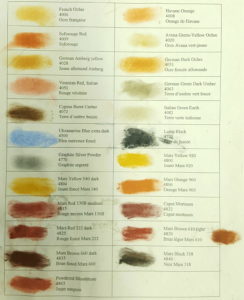We have two lines of pigment for colouring paper.
Our dry powder pigments are just that: Fine-grained powders that can be used to colour things. To use these, they have to be mixed with water in a manner that separates all the pigment particles. The particles tend to like to stick together in clusters around a tiny air bubble, where the surface tension holds everything together. This clustering can make the colour grainier than it should be, and somewhat reduces its darkness. Anyone who has even made their own paint or ink from dry pigment would be familiar with the process of mulling, that is, rubbing a pasty preparation of the pigment between two surfaces to break up the clusters. This treatment is recommended but not essential when using our dry pigments in paper.
Our aqueous-dispersed pigments are in liquid/paste form, and as the name implies, they are supplied with the pigment dispersed in a water-based liquid. The big advantage is that there is no need for mulling: the pigments are already properly dispersed when you get them. They can also be measured by volume, which many people find more convenient than weighing out products.
We don’t have a general set of colour samples available, but one of our blog posts shows what colour intensity you might expect from various doses of our Red 112 liquid pigment.
We also have four colours of marble dust, which provide both a gritty texture and pale colour to paper it is used in. Such paper should not be used in any printing equipment, nor should you attempt to write on it with a fountain pen or calligraphy pen. The grit would quickly damage the printing/drawing equipment. On the other hand, gritty paper is great for dry media like chalk, conté, or pastels, since it provides such good tooth.

